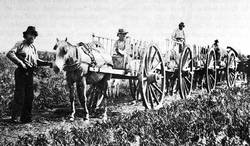1801 – 1870s
It can be safely said that modern civilization would not exist without the invention of the wheel. The wheel as a means of transportation did not exist on what came to be Manitoba's prairies until just after the turn of the 19th century when the Red River cart made its appearance. The cart played a huge role in the success of both the fur trade and Red River Métis bison hunts.
Transporting the Goods of the Fur Trade
At the beginning of the fur trade transportation depended on routes provided by waterways. But as trappers and traders began striking deeper into the interior, being forced to stick by lakes and rivers became limiting. At this time the only way to transport goods overland was by loading packs on the back of a man or horse, or using a travois drawn by horse or dog. A vehicle of travel suited to the interior fur trade became imperative as traders moved into land not accessible by river. Trade was also growing and boats could no longer handle the freight that required transportation.
The Red River Cart
The Red River cart was born along the river that gave it its name. The first record of the two-wheeled vehicle being made was at Fort Pembina, just south of the 49th parallel. The North West Company trader Alexander Henry Jr. taught the men at his fort how to construct the cart.

It took a few years for the design to be perfected. In the beginning the wheels were simply sawn off the end of logs, about three feet (one meter) in diameter and solid wood. The next year the design included four spokes. The year after that saw a general “dished” shape to the wheel appear, formed by spokes inclining outward from the cart body. Dished wheels gave the cart better stability by preventing tipping. They also made it easier to free the cart from muddy sections of the trail and came in handy when crossing a river. The wheels could be removed from the cart and lashed together to form a sort of raft that the body of the cart was set on top of before getting ferried across the river.
There were no standard measurements used in the cart's construction, thus wheel diameters could fall anywhere between three and six feet, and the number of spokes reached as high as 16.
One of the assets of the Red River cart was that its construction required nothing more than simple tools. The entire cart was built exclusively of wood, making repairs easy to accommodate when out on the trail. Wet strips of rawhide were sometimes wound around the wheel rim where they dried to form a “tire.”
A horse or ox was used to pull the cart. An ox could pull up to 900 pounds (400 kgs) and travel a maximum of 25 miles (40 kms) a day. The speed was greatly increased with a horse, which could make 50 to 60 miles (80 to 96 kms) a day but with a load of only 500 pounds (230 kgs). The carts were renowned for the unearthly shriek they made as they trundled along, a phenomenon that could not be rectified. Greasing the axle was found to be ineffective as dust from the trail congealed the grease so the wheel couldn't turn at all.
The Red River cart had more uses than simply that of a hauling device: sometimes saplings were bent into a semi-circle and attached to the side rails. After a piece of canvas was affixed over top, the cart was transformed into a shelter, providing protection from sun and inclement weather.
Use of the Red River cart as the chief method of overland travel and transport on the prairies peaked in 1869. Eventually, vehicles powered by animals became inadequate for the volume of traffic and the increasing demands of the market for faster moving merchandise. Alternate transportation options began appearing on the prairies. First the steamboat, followed closely by the railroad. By the mid 1870s the Red River cart was seldom seen and faded instead into the pages of history. Today the Red River cart has become a symbol of the pioneer era of Manitoba.
. . . . .
Related Articles:
. . . . .
Author: Teyana Neufeld, 2009.
Sources:
Brehaut, Harry B. “The Red River Carts.” 1968. Manitoba Historical Society. 20 Nov. 08. http://www.mhs.mb.ca/pageant/redrivercarts.shtml
---. “The Red River Cart and Trails: The Fur Trade.” 1971-2. Manitoba Historical Society. 20 Nov. 08. http://www.mhs.mb.ca/docs/transactions/3/redrivercart.shtml
Palk, Helen. “Pages from Canada's Story.” Historic Resources Branch Manitoba Culture, Heritage, Tourism and Sport. Misc. Materials Relating to the Heritage Resources of the Turtle Mountain/Souris Plains Region of Manitoba. CD-ROM. Winnipeg: 2008.
